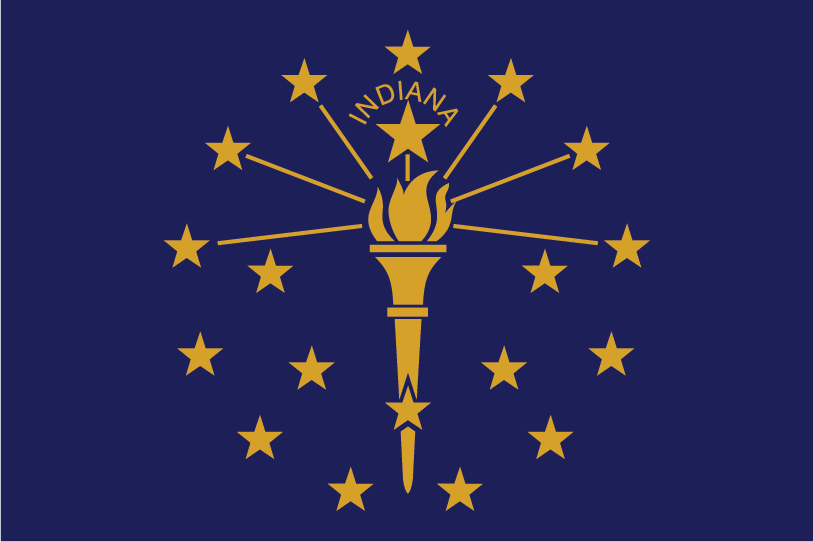Access to health care should be a priority for those who have fought for our country, yet many challenges and barriers make it difficult for veterans to receive the care they need. Aside from navigating the VA system and getting approved for health care benefits, some states have limited veteran health care facilities, making wait times and access to care harder.
We analyzed data from the U.S. Department of Veteran Affairs and Medicare.gov to determine the most accessible states for veteran health care, accounting for the number of VA health care facilities, average star ratings for VA hospitals, total VA medical care spending, and more.
In this guide, we’ll highlight the states with the easiest access to veteran health care, states where access is more difficult, the factors that impact access to care, and resources for veterans looking for additional support.
Key findings:
- California is the most accessible state for veteran health care, with the nation’s highest number of VA health care facilities.
- Guam is the least accessible state for veteran health care due to the limited number of health care facilities on the island.
- Texas has the highest veteran population and spent the most on VA expenditures in 2023 compared to any other state.
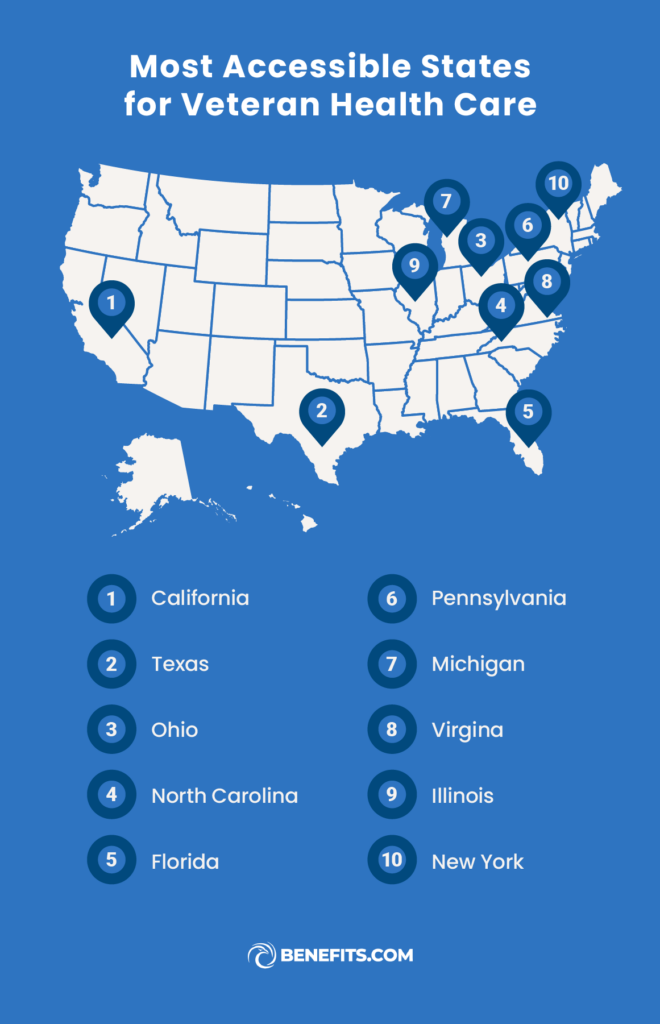
Based on data from the U.S. Department of Veteran Affairs and Medicare.gov, our findings deemed the following states the most accessible for veteran health care.
1. California
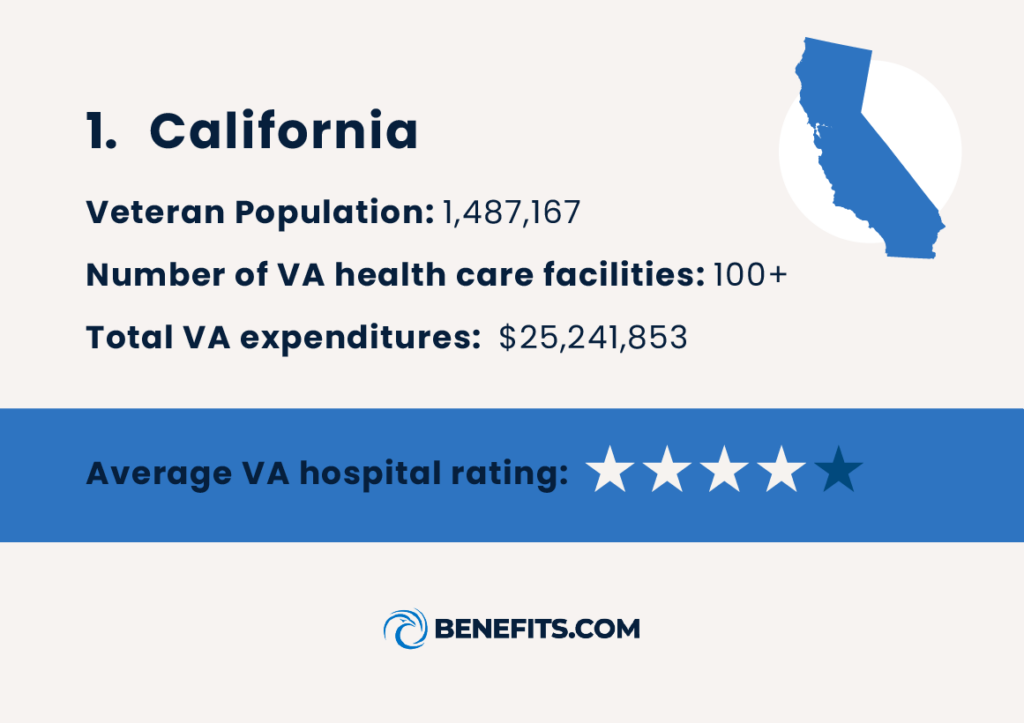
California is the number one most accessible state for veteran health care. California is home to over 1 million veterans, almost 4% of the total population.
The state also has over 100 VA health care facilities, including hospitals, outpatient clinics, and community centers, ensuring residing veterans have access to a wide range of care. The average star rating for VA hospitals in California is four, indicating better patient satisfaction and overall accessibility.
- Number of VA health care facilities: 100+
- Total VA expenditures: $25,241,853
- Total VA expenditures toward medical spending: $9,629,137
- Average VA hospital rating: 4 stars
- Number of patients who received treatment at a VA facility: 453,584
2. Texas
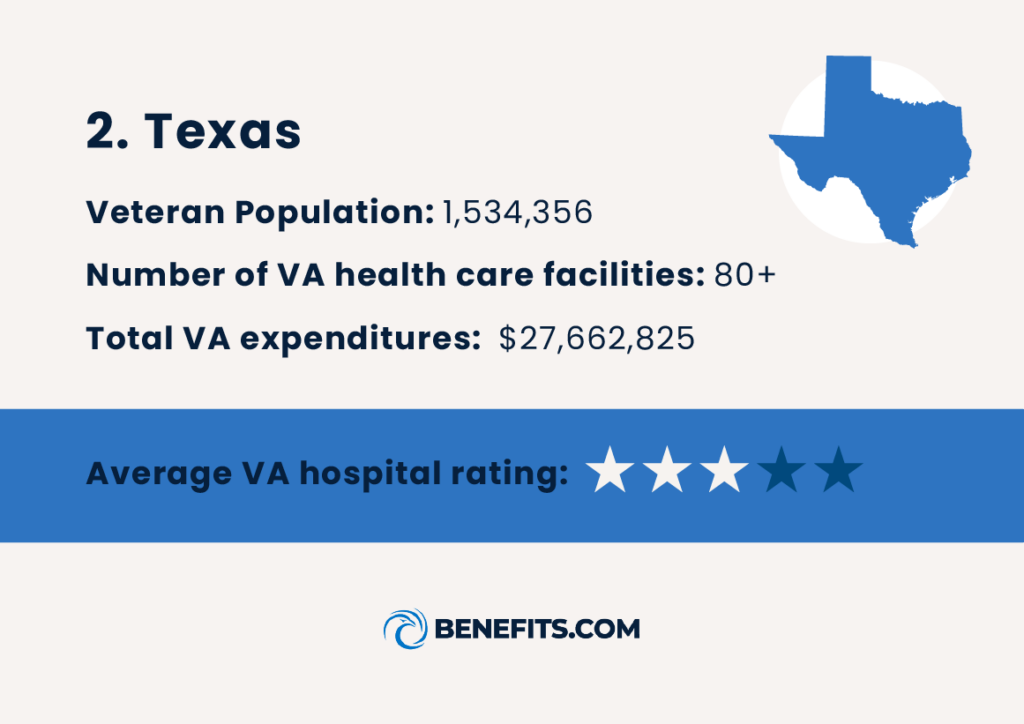
Home to 1.5 million veterans, Texas takes the number two spot for the states with the best access to VA health care. In 2023, Texas spent over $27 million in VA expenditures, with $9.2 million distributed toward medical care spending. As the state with the highest population of veterans, Texas has over 80 VA health care facilities and is home to the Temple VA Medical Center, Texas’ five-star VA hospital.
- Number of VA health care facilities: 80+
- Total VA expenditures: $27,662,825
- Total VA expenditures toward medical spending: $9,232,974
- Average VA hospital rating: 3 stars
- Number of patients who received treatment at a VA facility: 567,360
3. Ohio
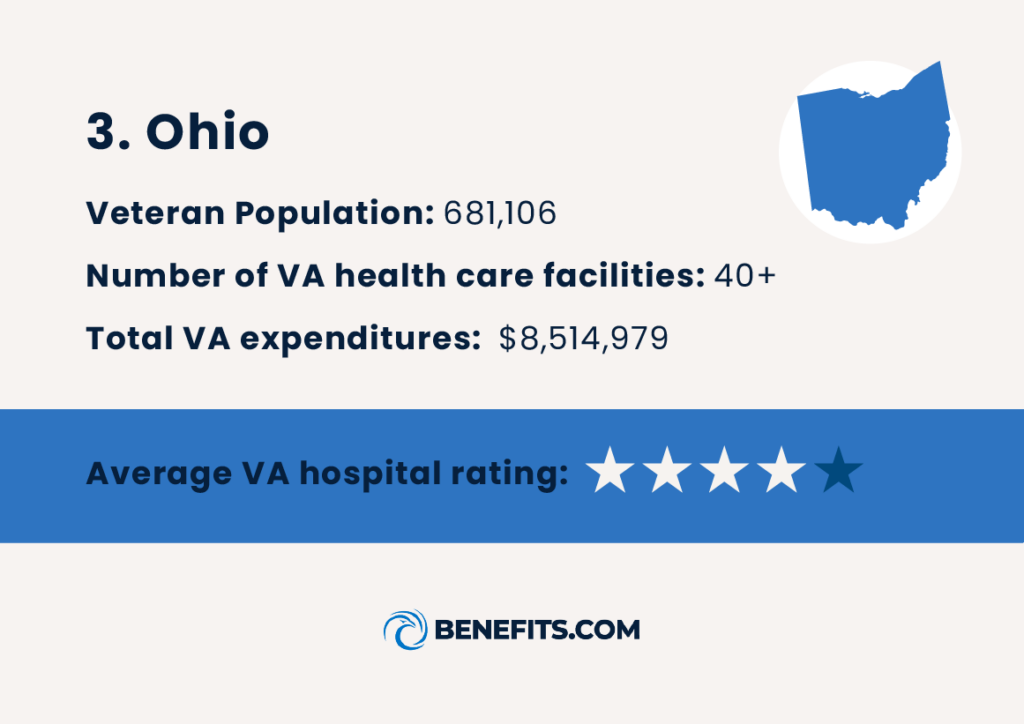
Ohio ranks third as the most accessible state for veteran health care. In 2023, half of Ohio’s VA expenditures went toward medical spending ($4,186,044), showing its investment toward veteran health. VA hospitals in Ohio have an average rating of four, and veterans have access to over 40 health care facilities across the state.
Ohio’s VA facilities also have one of the lowest average wait times in the U.S. — averaging around 22 days for new patients receiving primary care services.
- Number of VA health care facilities: 40+
- Total VA expenditures: $8,514,979
- Total VA expenditures toward medical spending: $4,186,044
- Average VA hospital rating: 4 stars
- Number of patients who received treatment at a VA facility: 234,970
4. North Carolina
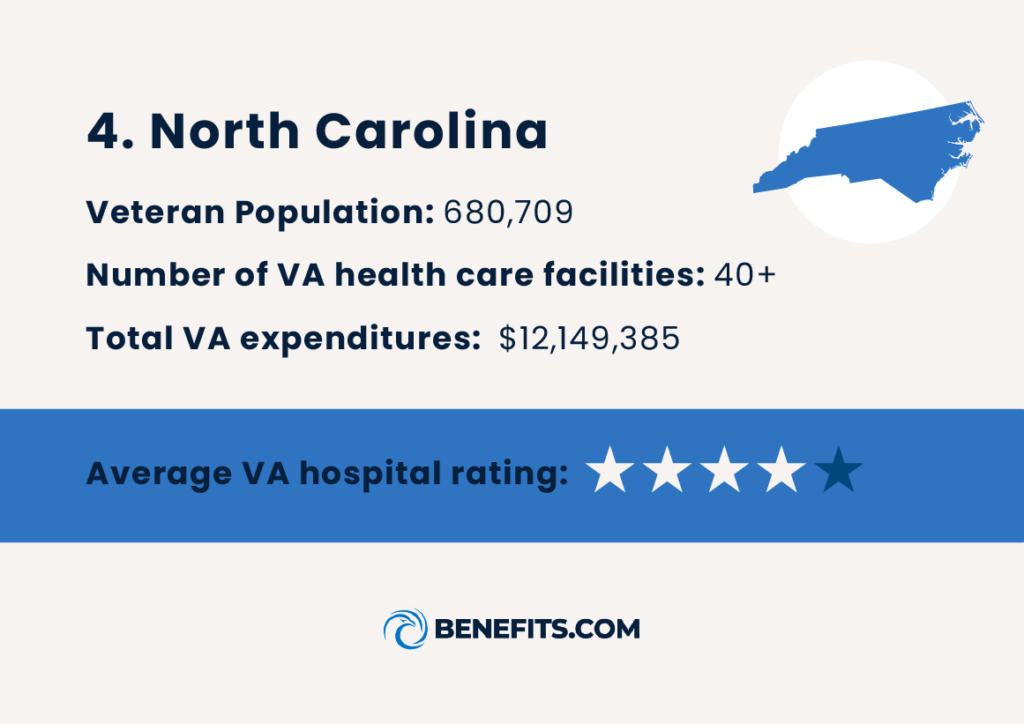
North Carolina houses 680,709 veterans, making up around 6% of the state’s total population. North Carolina is also in the top five states for the most spent on VA expenditures, with $4,121,328 going toward medical care spending in 2023.
Two of North Carolina’s VA hospitals have a five-star rating, including Asheville VA Medical Center and W.G. (Bill) Hefner VA Medical Center (Salsbury), and the state has over 40 VA health care facilities, proving the state’s commitment to providing quality care to its veterans.
- Number of VA health care facilities: 40+
- Total VA expenditures: $12,149,385
- Total VA expenditures toward medical spending: $4,121,328
- Average VA hospital rating: 4 stars
- Number of patients who received treatment at a VA facility: 263,407
5. Florida
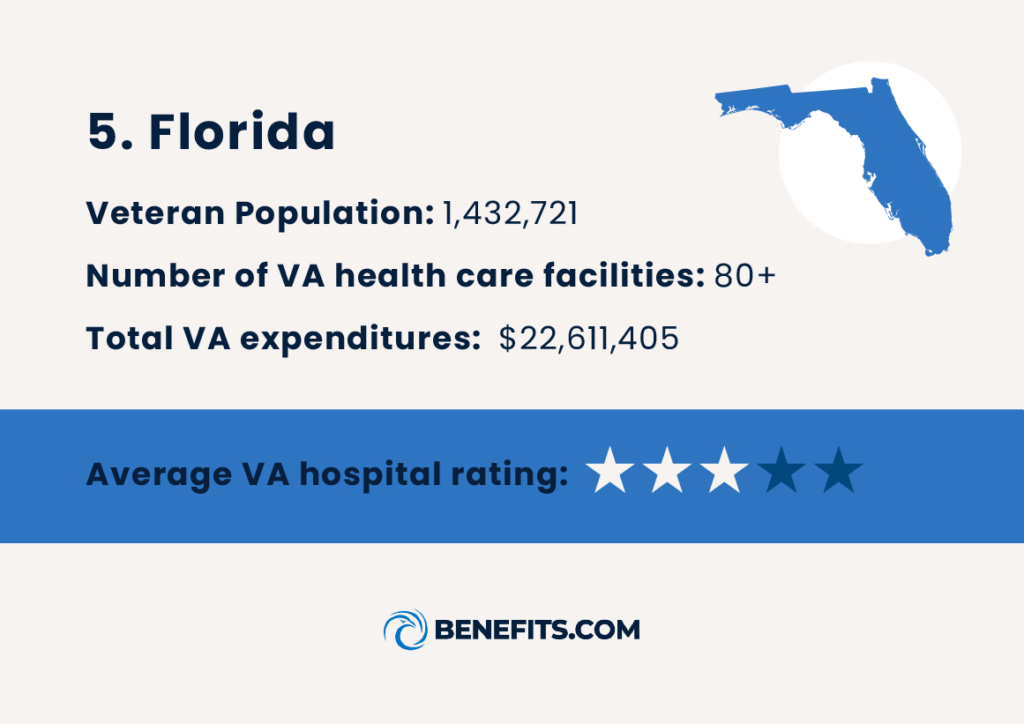
Florida has the third largest veteran population in the U.S. and ranks number five as the most accessible state for veteran health care. Florida has over 80 VA medical care facilities, including VA hospitals, community-based clinics, and outpatient services, ensuring accessibility to all veterans.
One of the most noteworthy hospitals in Florida is the Orlando VA Medical Center, which has a five-star rating. Florida also spent $8.8 million on VA medical care spending, with a strong emphasis on mental health services to prevent suicide among veterans.
- Number of VA health care facilities: 80+
- Total VA expenditures: $22,611,405
- Total VA expenditures toward medical spending: $8,821,731
- Average VA hospital rating: 3 stars
- Number of patients who received treatment at a VA facility: 554,965
6. Pennsylvania
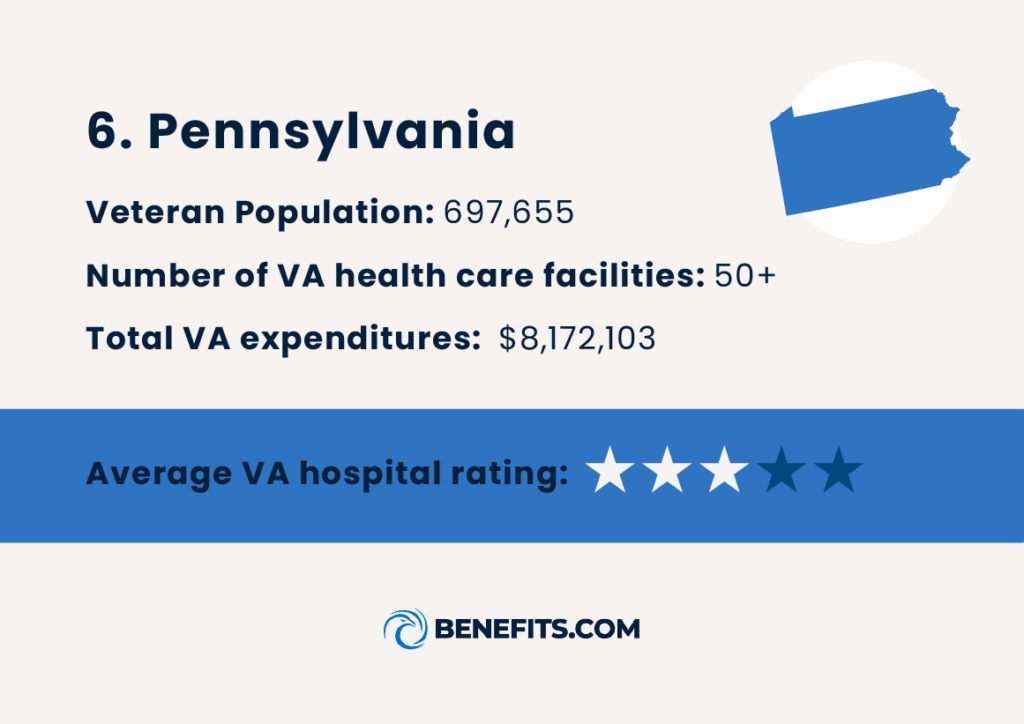
Pennsylvania ranks number six as the most accessible state for veteran health care. With the fourth largest population of veterans, this state has 58 VA medical facilities and is committed to providing care to veterans across the state.
The Lebanon VA Medical Center has a five-star rating, with an average wait time of 11 days for new patients and three days for existing patients regarding primary care services, which is fairly low compared to other states.
- Number of VA health care facilities: 50+
- Total VA expenditures: $8,172,103
- Total VA expenditures toward medical spending: $3,816,996
- Average VA hospital rating: 3 stars
- Number of patients who received treatment at a VA facility: 221,184
7. Michigan

Michigan comes in as the seventh-best state for veteran health care access. The state provides access to over 40 VA health care facilities, with top VA hospitals receiving an average star rating of four.
The Lieutenant Colonel Charles S. Kettles VA Medical Center has a five-star overall hospital rating and a five-star patient survey rating — which considers patients’ experiences regarding the care they’ve received.
- Number of VA health care facilities: 40+
- Total VA expenditures: $6,315,431
- Total VA expenditures toward medical spending: $2,717,610
- Average VA hospital rating: 4 stars
- Number of patients who received treatment at a VA facility: 158,647
8. Virginia

Virginia is home to over 600,000 veterans, making up about 8% of the state’s population. VA medical centers in Virginia have a four-star average rating, with the top-rated hospital being Salem VA Medical Center. This hospital has earned five stars based on the quality of care and has a low wait time of two days for veterans seeking primary care integrated mental health services.
- Number of VA health care facilities: 25+
- Total VA expenditures: $9,947,671
- Total VA expenditures toward medical spending: $2,755,368
- Average VA hospital rating: 4 stars
- Number of patients who received treatment at a VA facility: 186,728
9. Illinois
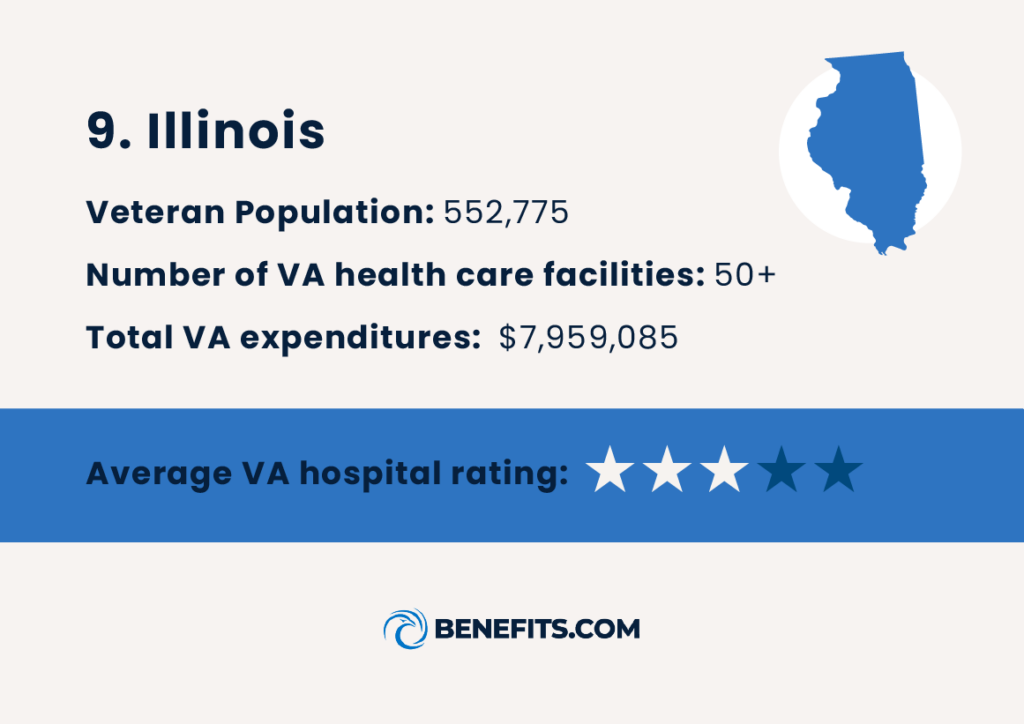
With more than 50 VA health care facilities, Illinois is one of the top-ranked states for accessible care for veterans. Total VA expenditures exceeded $7.9 million in 2023, with $3.2 million dedicated to medical care spending. The Illinois Department of Veteran Affairs (IDVA) also has the Illinois Veterans’ Homes program, which offers long-term care services to veterans and eligible spouses.
- Number of VA health care facilities: 50+
- Total VA expenditures: $7,959,085
- Total VA expenditures toward medical spending: $3,240,048
- Average VA hospital rating: 3 stars
- Number of patients who received treatment at a VA facility: 162,984
10. New York
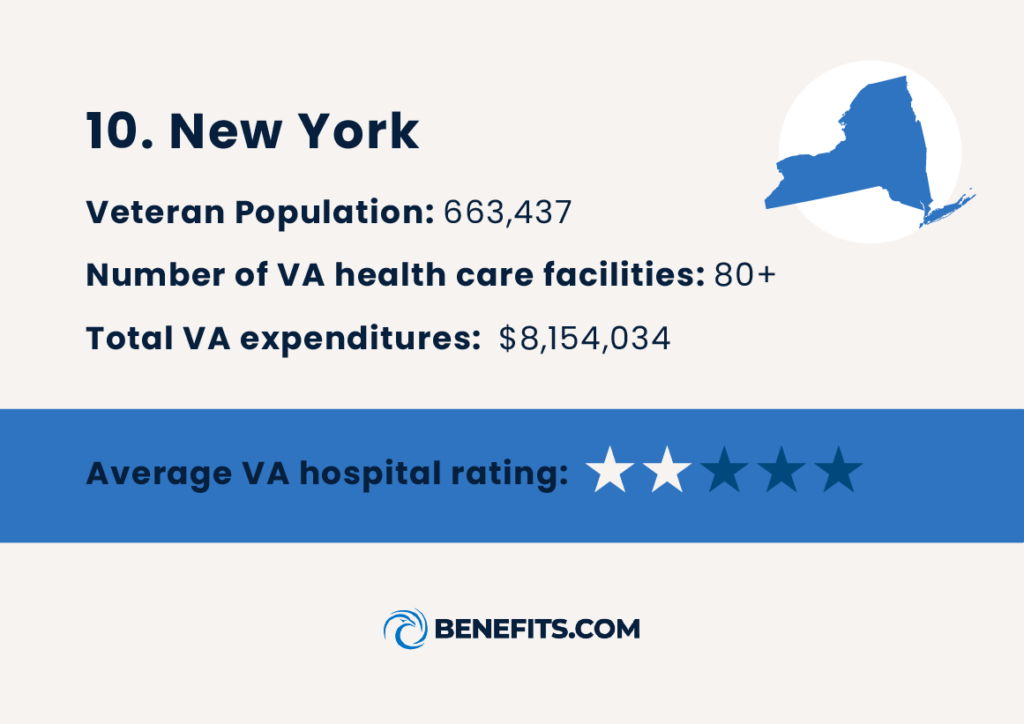
Finally, New York ranks tenth for accessible veteran health care. The state has the ninth-largest veteran population and over 80 VA health care facilities, including hospitals, outpatient clinics, community-based clinics, and Vet centers. Aside from that, there are many VA medical centers and clinics in states nearby, like New Jersey, making it easy to access care for those in bordering areas.
The Buffalo VA Medical Center has a four-star overall rating and a four-star patient survey rating. In 2023, $8,154,034 went to VA expenditures, with almost half ($3,951,751) spent on medical care.
- Number of VA health care facilities: 80+
- Total VA expenditures: $8,154,0
- Total VA expenditures toward medical spending: $3,951,751
- Average VA hospital rating: 2 stars
- Number of patients who received treatment at a VA facility: 197,534
Least Accessible States For Veteran Health Care
Below, we’ve highlighted some of the states where accessing veteran health care might be more difficult.
Guam
Guam is one of the hardest states to receive veteran health care simply because of the limited number of VA health care facilities on the island. Guam has one veteran center and one VA clinic for the 12,543 veterans — which makes up a little of 7% of the total population.
The Guam VA clinic also has an extremely long wait time of 51 days for new primary care patients, making it challenging to even get in for an initial appointment.
Rhode Island
Rhode Island is home to over 50,000 veterans, but unfortunately has a limited number of VA health care facilities available. Out of the three facilities, the Providence VA Medical Center has a 1-star rating and an average wait time of 42 days for new patients and 11 days for established patients for primary care.
However, the wait time is significantly lower for those looking for primary care integrated mental health services, which has an average wait time of two days for new and existing patients.
Alaska
The veteran population in Alaska accounts for over 9% of the state’s total population. Though Alaska has nine VA health care facilities, many veterans live in remote areas and face harsh weather conditions that can make access to VA clinics or specialized care services difficult.
However, Alaska has been helping veterans overcome these challenges by launching programs like the Digital Divide Consult Program. This program offers veterans free internet-connected tablets with cellular service to make it easy for them to access health care appointments through telehealth services when needed.
The Disabled American Veterans (DAV) also provides free rides to and from the VA Medical Center in Anchorage.
New Hampshire
Veterans make up almost 7% of the total population in New Hampshire, but the single VA medical center in the state can make it difficult for veterans to get the care they need.
Aside from the geographical distance posing a challenge, the wait time for primary care at the Manchester VA Medical Center is 30 days for new patients and six days for established patients. Though Michigan has community-based outpatient clinics and Vet centers, receiving specialized care can be challenging.
Hawaii
Hawaii’s limited number of VA health care facilities makes it difficult for veterans to travel across islands to access care. The one VA medical center in Hawaii is in Honolulu, with the wait time for primary care averaging 45 days for new patients and five days for established patients.
Aside from clinics and Vet centers, accessing specialized care for complex health conditions can be challenging. However, Hawaii has introduced some new clinics, like the Daniel Kahikina Akaka VA Clinic, which helps provide better access to care for veterans in the surrounding area.
Key Factors Affecting VA Health Care Accessibility

While most veterans are eligible to receive health care benefits, many challenges may make it difficult to obtain proper care, including:
- Geographic location: The distance between a VA health care facility and a veteran’s location can significantly impact a person’s ability to access the care they need, especially for those in rural areas or smaller communities.
- Wait times: VA facilities experiencing overcrowding can lead to longer wait times to book appointments and get seen by a provider.
- Understanding of the VA system: Some veterans aren’t aware of the benefits and services available to them, which impacts their ability to get quality care. The VA health care system can also be difficult to navigate, which could prolong a veteran’s access to care.
- Condition severity: The severity of a veteran’s illness or condition also greatly influences access to proper care, as some specialized care services may not be available in every state.
- Age: The VA has many programs, health care benefits, and facilities to support elderly veterans. While many are available nationwide, specialized facilities, like the Geriatric Research, Education, and Clinical Centers (GRECCs), are limited. These centers help improve health care for older veterans through research and clinical programs, but with only 20 GRECCs across the country, access may be challenging for veterans living outside of the surrounding areas.
- Homelessness: In 2023, over 30,000 veterans were experiencing homelessness in the U.S. Though the VA has programs to help displaced veterans, this is a major factor impacting a person’s ability to receive adequate care.
Resources and Support for Veterans Seeking Care
Despite the challenges outlined above, there are a ton of resources to help better understand the veteran health care system. Check out the resources below for additional support regarding veteran health care.
- VA.gov Health Care Page: Learn eligibility requirements, how to apply for benefits, and more.
- VA.gov Facility Directory: Find your state to see the nearest VA health care facility options available in your area.
- Medicare.gov Care Compare: Search for top VA hospitals in your area and how they rank amongst others to find a clinic that works for you.
- VA Caregiver Support Program: Offers benefits and support services to those caring for a veteran.
- VA.gov Women Veterans Health Care: Discover resources and information regarding women-specific veteran care.
- VA.gov Homeless Programs: Connects homeless veterans with health care resources and support.
Get Veteran Health Care Help with Benefits.com
Understanding your eligibility for VA health care benefits is crucial to ensure you get access to the care you need. If you have questions regarding VA health care services, Benefits.com can help. Browse through our library of veteran resources to find the answers you need, or contact us for expert guidance and assistance regarding your health care options.
Methodology
To determine the most accessible states for veteran health care, we analyzed data from the U.S. Department of Veterans Affairs and Medicare.gov. We rated each state on a weighted scale based on the following factors:
- Total VA medical care spending: 25%
- Number of VA health care facilities: 25%
- Average star rating for VA hospitals: 20%
- Total VA expenditures: 15%
- Veteran population: 10%
- Number of patients who received treatment at a VA facility: 5%
 Benefits.com Advisors
Benefits.com Advisors
With expertise spanning local, state, and federal benefit programs, our team is dedicated to guiding individuals towards the perfect program tailored to their unique circumstances.
Rise to the top with Peak Benefits!
Join our Peak Benefits Newsletter for the latest news, resources, and offers on all things government benefits.
















